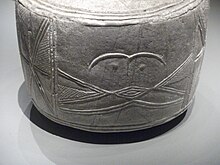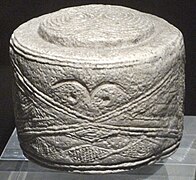Folkton Drums
| Folkton Drums | |
|---|---|
 Folkton Drums displayed in the British Museum | |
| Material | Chalk |
| Size | 8.7 cm (height) |
| Created | 2600–2100 BC |
| Discovered | 1889 |
| Present location | British Museum |
| Identification | P&EE 1893 12-28 15-17 |
The Folkton Drums are a unique set of three decorated chalk objects in the shape of drums or solid cylinders dating from the Neolithic period. Found in a child's grave near the village of Folkton in northern England, they are now on loan to Stonehenge Visitor Centre from the British Museum.[1] A similar object, the Lavant drum, was excavated in 1993 in Lavant, West Sussex.
Their purpose remains obscure. They were given the name "drum" to describe their shape, rather than from any thought they might be percussion instruments.
Discovery[]
In 1889, a round prehistoric barrow was opened by the scholar and amateur archaeologist William Greenwell near Folkton in North Yorkshire.[2] Inside, he found a neolithic grave dating to the time of Stonehenge, estimated to be between 2600 and 2000 BC. The remains of several bodies were unearthed, one of whom was a child beside which the three drums were found. The rarity of this find suggests that the child came from an elite group in society. Four years after the discovery, the drums were donated by Greenwell, along with other parts of his collection, to the British Museum.
Description[]
The three drum-like forms are made of locally quarried chalk and are decorated with stylized human faces and geometric patterns. On the top of the cylinders are a series of concentric circles and two of them have pairs of eyes that schematically denote a human face. The design of the drums is similar to objects made in the Beaker culture and early British Bronze Age. The purpose of the drums is not known for certain, although the dimensions of the drums may be significant: archaeologist Anne Teather notes that the circumferences of the drums form whole-number divisions (ten, nine and eight times, respectively) of ten long feet, a widely used unit of measure in Neolithic Britain.[3] Teather explains that the objects could have been a means of achieving standardisation at many locations, or as a teaching aid.[4] The study also proposes that the drums are ceremonial objects that have uniquely survived due to their unusual material, while most objects of this type may have been made out of wood.[3] The Lavant drum, excavated in 1993, was identified as being analogous to the Folkton drums in 2005 by Anne Teather.[5]
Detail of the schematic face on one of the drums
View of another face with prominent features
Side image of a drum with geometric patterns

Alternative view of the three drums
See also[]
References[]
- ^ "The Folkton Drums | British Museum". The British Museum. Retrieved 2021-04-24.
- ^ North, John (1996). Stonehenge : a new interpretation of prehistoric man and the cosmos. New York, NY: The Free Press. ISBN 1416576460. Retrieved 31 July 2014.
- ^ a b UCL (2018-12-21). "Folkton Drums could have been measuring devices used to build Stonehenge". UCL News. Archived from the original on 28 January 2019. Retrieved 2019-12-09.
- ^ Teather, Anne; et al. (8 February 2019). "Getting the Measure of Stonehenge". British Archaeology (165): 48–51.
- ^ Kenny, James; Teather, Anne M. (2016). "New insights into the Neolithic chalk drums from Folkton (North Yorkshire) and Lavant (West Sussex)". PAST: The Newsletter of the Prehistoric Society. 83: 5–6.
Bibliography[]
| Wikimedia Commons has media related to Folkton Drums. |
- H. Longworth, 'The Folkton Drums unpicked' in Grooved Ware in Britain and Ireland, Neolithic Studies Group Seminar Papers 3 (Oxford, Oxbow Books, 1999), pp. 83–88
- D.V. Clarke, T.G. Cowie and A. Foxon, Symbols of power at the time of Stonehenge (London, HMSO, 1985)
- I.A. Kinnes and I.H. Longworth, Catalogue of the excavated Prehistoric and Roman-British material in the Greenwell Collection (London, The British Museum Press, 1985)
- Prehistoric objects in the British Museum
- Stone Age sites in England
- Prehistoric art
- 1889 archaeological discoveries



